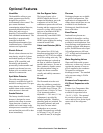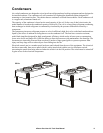InRoom Precision AC Tech Data Manual2
Scalable Solution for Critical Environments
Temperature and Humidity
Design Conditions
Maintenance of temperature and
humidity design conditions is
critical to the smooth operation of
a technology room. Based on
ASHRAE TC9.9, the
recommended design conditions
for class one and class two
environments should be 20–25°C
(68–77°F) and 40–55% relative
humidity (R.H.). Precision air
conditioning is designed to
maintain temperature at ±2°F and
humidity at ±3–5% R.H. 24 hours
a day, 365 days a year. Vapor
barriers and sealed rooms are
required to maintain these
tolerances. In contrast, comfort
systems are designed to maintain
±5°F from the temperature
setpoint. There is usually no
dedicated humidity control and
the simple controllers cannot
maintain the setpoint tolerance
required for temperature,
allowing potentially harmful
temperature and humidity swings
to occur. This is not acceptable for
sensitive electronic equipment.
Air Quality
Precision air conditioners provide
a high volume of air flow, around
600 CFM/ton (286 L/m, 150
CFM/kW). This high CFM moves
more air through the space
improving air distribution and
reducing the chance of localized
hot spots. It also allows more air
to move through filters, ensuring
a cleaner environment. This
requires a moderate-to high-
efficiency filter bank to minimize
airborne particles.
Low Humidity
Low humidity greatly increases
the possibility of static electric
discharges. Static discharges can
corrupt data and damage
hardware.
High Humidity
High humidity can result in tape
surface deterioration, head
crashes, condensation, corrosion,
paper handling problems and gold
and silver migration leading to
component and board failure.
High & Low Temperature
A high or low temperature or
rapid temperature swings can
corrupt data processing and shut
down an entire system.
Temperature variations can alter
the electrical and physical
characteristics of electronic chips
and other board components
causing faulty operation or
failure. These problems may be
transient or may last for days.
Transient problems can be very
difficult to diagnose and repair.
Efficiency and Reliability
The use of energy efficient, direct
drive fans along with fewer
moving internal parts eliminate
most potentials for failure. Scroll
compressor technology provides
unparalleled efficiency and con-
stant, reliable operation with an
ability to withstand liquid
refrigerant ‘slugging’ which is a
major cause of compressor fail-
ure. The compressor is also
equipped with an internal high
pressure sensor which opens a
bypass valve in case of high
pressure. This ensures internal
pressure compensation takes
place and damage to the
compressor is avoided.
APC InRoom -
The Right Solution
The APC InRoom cooling unit
provides the maximum amount of
precision cooling in a compact
footprint with the lowest
operating cost and noise level.
Dedicated Dehumidification
Cycle
A dedicated dehumidification
cycle allows the system to
increase latent capacity without
boosting compressor capacity,
and also lowers the requirement
for reheat. To achieve
dehumidification, the electronic
expansion valve is first partially
closed. The reduction of the
refrigerant mass flow makes the
evaporation temperature drop,
which lets the surface temperature
in a part of the evaporator fall
below the dew point of the air,
causing dehumidification. For
increased dehumidification, the
fan speed is reduced. With a
constant cooling capacity, the
temperature of the air which
flows through the heat exchanger
coil passes below the dew point.
The moisture contained in the air
condenses on the heat exchanger,
gathers in the condensate pan, and
is carried away by the drain. To
achieve humidification for the
DX units with cabinet size 1 and
all CW units, the fan speed is
reduced. For the DX units with
cabinet size 2–5, approximately
one third of the evaporator is
isolated from the refrigerant flow
by a solenoid valve to achieve
dehumidification by lowering the
evaporator temperature below the
dew point.


















